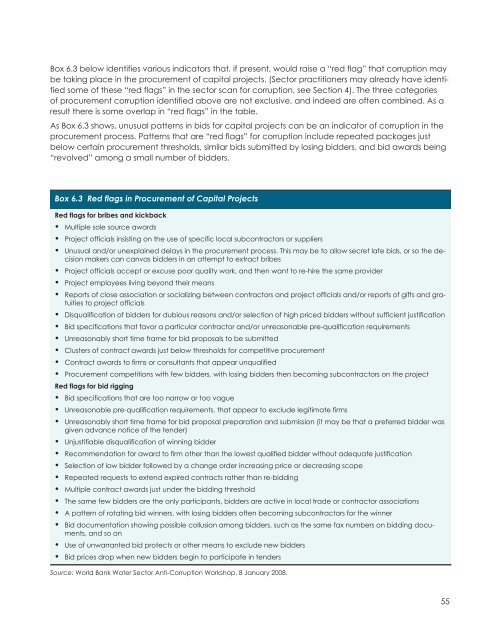A Sourcebook - UN-Water
A Sourcebook - UN-Water
A Sourcebook - UN-Water
You also want an ePaper? Increase the reach of your titles
YUMPU automatically turns print PDFs into web optimized ePapers that Google loves.
Box 6.3 below identifies various indicators that, if present, would raise a “red flag” that corruption may<br />
be taking place in the procurement of capital projects. (Sector practitioners may already have identified<br />
some of these “red flags” in the sector scan for corruption, see Section 4). The three categories<br />
of procurement corruption identified above are not exclusive, and indeed are often combined. As a<br />
result there is some overlap in “red flags” in the table.<br />
As Box 6.3 shows, unusual patterns in bids for capital projects can be an indicator of corruption in the<br />
procurement process. Patterns that are “red flags” for corruption include repeated packages just<br />
below certain procurement thresholds, similar bids submitted by losing bidders, and bid awards being<br />
“revolved” among a small number of bidders.<br />
Box 6.3 Red flags in Procurement of Capital Projects<br />
Red flags for bribes and kickback<br />
• Multiple sole source awards<br />
• Project officials insisting on the use of specific local subcontractors or suppliers<br />
• Unusual and/or unexplained delays in the procurement process. This may be to allow secret late bids, or so the decision<br />
makers can canvas bidders in an attempt to extract bribes<br />
• Project officials accept or excuse poor quality work, and then want to re-hire the same provider<br />
• Project employees living beyond their means<br />
• Reports of close association or socializing between contractors and project officials and/or reports of gifts and gratuities<br />
to project officials<br />
• Disqualification of bidders for dubious reasons and/or selection of high priced bidders without sufficient justification<br />
• Bid specifications that favor a particular contractor and/or unreasonable pre-qualification requirements<br />
• Unreasonably short time frame for bid proposals to be submitted<br />
• Clusters of contract awards just below thresholds for competitive procurement<br />
• Contract awards to firms or consultants that appear unqualified<br />
• Procurement competitions with few bidders, with losing bidders then becoming subcontractors on the project<br />
Red flags for bid rigging<br />
• Bid specifications that are too narrow or too vague<br />
• Unreasonable pre-qualification requirements, that appear to exclude legitimate firms<br />
• Unreasonably short time frame for bid proposal preparation and submission (it may be that a preferred bidder was<br />
given advance notice of the tender)<br />
• Unjustifiable disqualification of winning bidder<br />
• Recommendation for award to firm other than the lowest qualified bidder without adequate justification<br />
• Selection of low bidder followed by a change order increasing price or decreasing scope<br />
• Repeated requests to extend expired contracts rather than re-bidding<br />
• Multiple contract awards just under the bidding threshold<br />
• The same few bidders are the only participants, bidders are active in local trade or contractor associations<br />
• A pattern of rotating bid winners, with losing bidders often becoming subcontractors for the winner<br />
• Bid documentation showing possible collusion among bidders, such as the same fax numbers on bidding documents,<br />
and so on<br />
• Use of unwarranted bid protects or other means to exclude new bidders<br />
• Bid prices drop when new bidders begin to participate in tenders<br />
Source: World Bank <strong>Water</strong> Sector Anti-Corruption Workshop, 8 January 2008.<br />
55
















